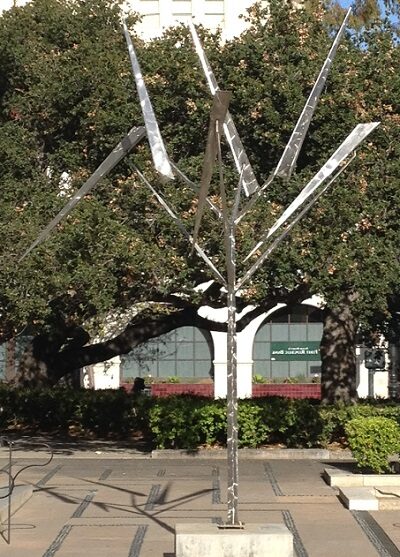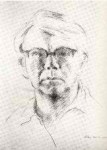
George Rickey
American, 1907 - 2002
Six Random Lines Eccentric III, 1992-1999
stainless steel
170 x 41 x 35 in.
SBMA, Gift of the Estate of George Rickey

Self-Portrait, pencil on paper, 1970 © VAGA, New York, NY
“A moment is the turning force on a weight on the end of an arm, and it is calculated by multiplying the weight times the distance. That is called a moment. A moment of rotation. If you want something in balance about a point, the moments must be equal on both sides.” - George Rickey
RESEARCH PAPER
George Warren Rickey was born in South Bend, Indiana, on June 6, 1907. When he was young, he enjoyed drawing and was very interested in academics, mathematics and sailing. Rickey was raised in Scotland and spent days at a time on his family’s sailboat learning the mechanics of wind currents and motion while sailing along the Scottish coastline. He was educated at Glenalmond College and received a degree in history from Balliol College, Oxford. He then traveled through Europe and studied art and painting in Paris for a short time. He began his career teaching and became an accomplished painter. He then worked at different schools across the United States as a visiting artist where he painted portraits, murals, and taught classes.
In 1942, he enlisted in the army as a gunnery instructor. While in the army, he had access to a machine shop where he began to make small, colorful mobiles. He was influenced by the mobiles of Alexander Calder, whose work was made primarily of aluminum, wire and paint, but unlike Calder, Rickey preferred to work with more geometric shapes and focus on balance. It was during his military years that Rickey became familiar with lightweight but strong aircraft materials: ball bearings, riveted sheet metal, and weights. These construction materials and techniques were the foundation for his later years when he began creating aerodynamic, lightweight, balanced kinetic sculpture.
After he was discharged from the army, Rickey studied art at NYU and then at the Chicago Institute of Design. After hearing several lectures on Constructivist, or mobile mechanical art style theories at the Institute in 1948, he devoted his artistic and mechanical endeavors to kinetic art, which is relating to, or resulting from motion. Kinetic art depends on movement for its effect. Rickey closely followed the abstract metal art of David Smith, and later visited Smith at his studio where he was introduced to more modern welding techniques. Rickey’s style dramatically changed as he reduced his forms to simple geometric shapes, limited his medium to stainless steel, and produced large-scale welded works. Unlike most kinetic artists, Rickey did not use an electric motor to move the parts of his sculpture, instead relying on the power of the wind.
Rickey made many of his large scale blade sculptures to be seen in outdoor public settings. He strove for his finished product to be beautifully finished with superb craftsmanship. After some trial and error, he devised a way to keep the blades from falling off in high winds. He invented a kind of shock absorber with the use of rubber and metal washers that would stretch out to slow down a blade, and then contract and absorb energy when the blade moved back. Rickey’s blade sculptures also used riveting and machining to create a finely polished finished product that seemed to move silently and effortlessly. His blade sculptures were based on the principle of a swinging pendulum with a weighted rod swinging from a fixed point.
In creating Six Random Lines Eccentric III, Rickey most likely used the same technique he used for his other blade sculptures that brought him international fame. He found that the most effective proportion was to keep five-sixths of the blades’ length above the fulcrum. The one-sixth below the fulcrum served as the ballast. (Gedeon p. 23). In the wide part of the blade, Rickey placed a small amount of lead which determined the distance and speed of each blade. Rickey’s blade sculptures were typically hollow and light weight so they move gracefully and quietly. One of his primary goals was for sculpture to be silent so that the viewer would watch the movement in a quiet, poetic moment, to see the moment of rotation. He wanted his audience to notice during the moment of rotation how the blades would cut through time and space. Rickey’s sculpture is a study in opposition. His forms may appear simple, but their movement is complex. They can move from a slight breeze or from the touch of a hand, yet they can withstand winds up to 80 miles an hour.
Rickey did not produce his first Kinetic sculpture until he was thirty-eight years old. Kinetic sculpture in the early 1950‘s was considered to be very radical and modern. Kinetic art was called “the movement movement”. (Rosenthal, p. 13). At thirty-eight years of age, Rickey was one of the oldest artists working in the Kinetic art movement. He began producing blade works even later in life, and at the age of fifty seven he achieved international fame for his blade sculptures. When he began making Six Random Lines Eccentric III, he was eighty-five, and when he completed it he was ninety-two years old. Rickey was an artist and mechanical genius with a very long, prolific career.
Prepared for the Santa Barbara Museum of Art Docent Council by Christy Close, April 8, 2013.
BIBLIOGRAPHY
Finn, D (1989). How to Look at Sculpture. New York: NY. Harry N. Abrams.
Hale, NC (1968). Welded Sculpture. New York: NY. Watson-Guptill Publications.
Padovano, A (1981). The Process of Sculpture. Garden City: NY. Doubleday and Company, Inc.
Rosenthal, N (1977). George Rickey. New York: NY. Harry N. Abrams.
UCLA (1993). In the Sculptor’s Landscape. Los Angeles: CA. Wight Art Gallery.
Vero Beach Museum of Art (2007). George Rickey Kinetic Sculpture: A Retrospective. Vero Beach: FL. Vero Beach Museum of Art.
http://www.artnet.com/awc/george-rickey.html
http://www.aaa.si.edu/Collections/Interviews/Oral-History-Interview-George-Rickey-13050
